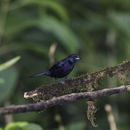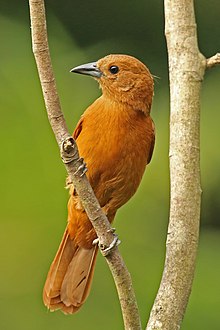en
names in breadcrumbs


Distribucion General: Se encuentra desde Costa Rica y Trinidad hasta el noroeste de Ecuador, norte de Bolivia, noreste de Argentina y el sureste de Brasil.
'''Tachyphonus rufus, tamién denomináu fruteru negru, parlotero malcasado y tangara forriblanca,[2] ye una especie d'ave paseriforme de la familia de les tangaras (Thraupidae). Distribúise dende Costa Rica al norte d'Arxentina, incluyendo la cuenca amazónica, y les islles caribeñes de Trinidá y Tobagu. Nun tien descrites subespecies.[3][4]
Ye un páxaru pequeñu que mide alredor de 18,5 cm. El machu ye de plumaxe negru sacante una llista nel cantu de la nala y la parte inferior de les coberteras, dambes blanques. La fema ye por completu marrón acoloratada, daqué más pálida per debaxo. El so picu ye gris azuláu, más escuru nel quexal cimeru.[5]
 Esta páxina forma parte del wikiproyeutu Aves, un esfuerciu collaborativu col fin d'ameyorar y organizar tolos conteníos rellacionaos con esti tema. Visita la páxina d'alderique del proyeutu pa collaborar y facer entrugues o suxerencies.
Esta páxina forma parte del wikiproyeutu Aves, un esfuerciu collaborativu col fin d'ameyorar y organizar tolos conteníos rellacionaos con esti tema. Visita la páxina d'alderique del proyeutu pa collaborar y facer entrugues o suxerencies. '''Tachyphonus rufus, tamién denomináu fruteru negru, parlotero malcasado y tangara forriblanca, ye una especie d'ave paseriforme de la familia de les tangaras (Thraupidae). Distribúise dende Costa Rica al norte d'Arxentina, incluyendo la cuenca amazónica, y les islles caribeñes de Trinidá y Tobagu. Nun tien descrites subespecies.
Ye un páxaru pequeñu que mide alredor de 18,5 cm. El machu ye de plumaxe negru sacante una llista nel cantu de la nala y la parte inferior de les coberteras, dambes blanques. La fema ye por completu marrón acoloratada, daqué más pálida per debaxo. El so picu ye gris azuláu, más escuru nel quexal cimeru.
Aderyn a rhywogaeth o adar yw Tanagr gwyn dan adain (sy'n enw gwrywaidd; enw lluosog: tanagrod gwyn dan adain) a adnabyddir hefyd gyda'i enw gwyddonol Tachyphonus rufus; yr enw Saesneg arno yw White-lined tanager. Mae'n perthyn i deulu'r Breision (Lladin: Emberizidae) sydd yn urdd y Passeriformes.[1]
Talfyrir yr enw Lladin yn aml yn T. rufus, sef enw'r rhywogaeth.[2] Mae'r rhywogaeth hon i'w chanfod yn Ne America a Gogledd America.
Mae'r tanagr gwyn dan adain yn perthyn i deulu'r Breision (Lladin: Emberizidae). Dyma rai o aelodau eraill y teulu:
Rhestr Wicidata:
rhywogaeth enw tacson delwedd Bras Brewer Spizella breweri Bras coed Spizella arborea Bras llwydaidd Spizella pallida Bras meysydd Spizella pusilla Bras Pigddu Spizella passerina Bras Worthen Spizella wortheni Pila mynydd cynffonwyn Phrygilus alaudinus Pila mynydd galarus Phrygilus fruticeti Pila mynydd gyddfwyn Phrygilus erythronotus Pila mynydd llwyd Phrygilus unicolor Pila mynydd llwytu Phrygilus carbonarius Pila mynydd Patagonia Phrygilus patagonicus Pila mynydd penddu Phrygilus atriceps Pila mynydd penllwyd Phrygilus gayi Pila mynydd Periw Phrygilus punensisAderyn a rhywogaeth o adar yw Tanagr gwyn dan adain (sy'n enw gwrywaidd; enw lluosog: tanagrod gwyn dan adain) a adnabyddir hefyd gyda'i enw gwyddonol Tachyphonus rufus; yr enw Saesneg arno yw White-lined tanager. Mae'n perthyn i deulu'r Breision (Lladin: Emberizidae) sydd yn urdd y Passeriformes.
Talfyrir yr enw Lladin yn aml yn T. rufus, sef enw'r rhywogaeth. Mae'r rhywogaeth hon i'w chanfod yn Ne America a Gogledd America.
The white-lined tanager (Tachyphonus rufus) is a medium-sized passerine bird in the tanager family Thraupidae. It is a resident breeder from Costa Rica south to northern Argentina, and on the islands of Trinidad and Tobago.
The white-lined tanager was described by the French polymath Georges-Louis Leclerc, Comte de Buffon in 1779 in his Histoire Naturelle des Oiseaux from specimens collected in Cayenne, French Guiana.[2] The female bird was also illustrated in a hand-coloured plate engraved by François-Nicolas Martinet in the Planches Enluminées D'Histoire Naturelle which was produced under the supervision of Edme-Louis Daubenton to accompany Buffon's text.[3] Neither the plate caption nor Buffon's description included a scientific name but in 1783 the Dutch naturalist Pieter Boddaert coined the binomial name Tangara rufa in his catalogue of the Planches Enluminées.[4] The white-lined tanager is now placed in the genus Tachyphonus that was introduced by the French ornithologist Louis Pierre Vieillot in 1816 with the white-lined tanager as the type species.[5][6][7] The name combines the Ancient Greek words takhus "fast" and phōneō "to speak".[8] The specific rufus is Latin for "red", "ruddy" or "rufous".[9] The species is monotypic: no subspecies are recognised.[7]
The adult white-lined tanager is 18.5 cm (7.3 in) long and weighs 33 g (1.2 oz). It has a long tail and a mostly black stout pointed bill. The adult male is glossy black, apart from white underwing coverts and a small white patch on the upperwing. These white areas are conspicuous in flight but otherwise rarely visible. Females and immatures are entirely rufous in plumage, somewhat paler below.
It occurs in semi-open areas including gardens.
In the breeding season, the male displays the white spots which he has under his wings, opening them and closing them before in front of the female.[10] The bulky cup nest is built in a tree or shrub, and the female incubates three, sometimes two, brown-blotched cream eggs for 14–15 days. This species has, on average, two broods per season.[10] They appear to be territorial, as only one nesting pair is usually seen in an area. They rarely join mixed feeding flocks.[10] The white-lined tanager's song is a fast repetitive cheeru.
These are restless but unwary birds which eat a wide variety of fruit, but especially epiphytes. They also take some nectar and insects, including beetles, ants and grasshoppers.
Local names in Trinidad and Tobago include 'Parson' (for the male), and 'Singing Angel'; on these islands, the species is highly valued for its whistling ability.
pair feeding at Asa Wright Nature Centre
The white-lined tanager (Tachyphonus rufus) is a medium-sized passerine bird in the tanager family Thraupidae. It is a resident breeder from Costa Rica south to northern Argentina, and on the islands of Trinidad and Tobago.
La tangara negra[4] (Tachyphonus rufus), también denominada frutero negro (en Paraguay y Argentina), parlotero malcasado (en Colombia, tangara forriblanca (en Costa Rica), tangara filiblanca (en Panamá y Ecuador), tangara de líneas blancas (en Perú), frutero chocolatero o chocolatero (en Venezuela),[3] es una especie de ave paseriforme de la familia Thraupidae perteneciente al género Tachyphonus. Es nativa de América Central y del Sur.
Se distribuye de forma discontínua en una inmensa área que abarca desde Costa Rica a Panamá; en Colombia, al sur por el oeste, en el oeste de Ecuador y norte y sureste de Perú; hacia el este por Venezuela, Trinidad y Tobago, norte de Guyana, Surinam y Guayana Francesa, hacia el sur por la parte oriental de la Amazonia brasileña, este, centro oeste y parte del sureste interior de Brasil, este de Bolivia, Paraguay, hasta el centro de Argentina (noreste de Buenos Aires).[1]
Esta especie, ampliamente diseminada, es bastante común en una variedad de hábitats naturales: clareras arbustivas, bordes de bosque y jardines; es más numerosa en Trinidad y Tobago donde inclusive habita en el interior de los bosques. Principalmente por debajo de los 1500 m de altitud, pero puede llegar hasta los 2000 m en algunos valles andinos.[5]
Mediano, mide alrededor de 18,5 cm. El macho es de plumaje negro a excepción de una lista en el borde del ala y la parte inferior de las coberteras, ambas blancas. La hembra es por completo marrón rojiza, algo más pálida por debajo. Su pico es gris azulado, más oscuro en la mandíbula superior.[6]
La especie T. rufus fue descrita por primera vez por el naturalista neerlandés Pieter Boddaert en 1783 bajo el nombre científico Tangara rufa; su localidad tipo es: «Cayena, Guayana Francesa».[3]
El nombre genérico masculino «Tachyphonus» deriva de la palabra griega «takhuphōnos, que significa «que habla rápido, parlachín»; y el nombre de la especie «rufus», del latín: rufo, rojizo, en referencia al color de la hembra de la especie.[7]
Es monotípica. Los amplios estudios filogenéticos recientes de Burns et al. (2014) demuestran que esta especie es hermana de Tachyphonus coronatus y el par formado por ambas es hermano de Tachyphonus phoenicius.[8]
La tangara negra (Tachyphonus rufus), también denominada frutero negro (en Paraguay y Argentina), parlotero malcasado (en Colombia, tangara forriblanca (en Costa Rica), tangara filiblanca (en Panamá y Ecuador), tangara de líneas blancas (en Perú), frutero chocolatero o chocolatero (en Venezuela), es una especie de ave paseriforme de la familia Thraupidae perteneciente al género Tachyphonus. Es nativa de América Central y del Sur.
Tachyphonus rufus Tachyphonus generoko animalia da. Hegaztien barruko Thraupidae familian sailkatua dago.
Tachyphonus rufus Tachyphonus generoko animalia da. Hegaztien barruko Thraupidae familian sailkatua dago.
Tachyphonus rufus

Le Tangara à galons blancs (Tachyphonus rufus) est une espèce de passereaux appartenant à la famille des Thraupidae.
On le trouve du Costa Rica jusqu'au nord de l'Argentine, et sur Trinité-et-Tobago.
Tachyphonus rufus
 Femelle tangara à galons blancs à Trinité-et-Tobago. Décembre 2014.
Femelle tangara à galons blancs à Trinité-et-Tobago. Décembre 2014. Le Tangara à galons blancs (Tachyphonus rufus) est une espèce de passereaux appartenant à la famille des Thraupidae.
De zwarte tangare (Tachyphonus rufus) is een zangvogel uit de familie Thraupidae (tangaren).
Deze soort komt voor in de laaglanden van Costa Rica tot noordelijk Argentinië en amazonisch Brazilië.
De zwarte tangare (Tachyphonus rufus) is een zangvogel uit de familie Thraupidae (tangaren).
A pipira-preta (Tachyphonus rufus) é uma ave passeriforme de tamanho médio da família tanager Thraupidae . É um criador residente do sul da Costa Rica ao norte da Argentina e nas ilhas de Trinidad e Tobago.
A pipira-preta foi descrito pelo polímata francês Georges-Louis Leclerc, conde de Buffon em 1779 em sua Histoire Naturelle des Oiseaux a partir de espécimes coletados em Caiena, Guiana Francesa. [1] A ave fêmea também foi ilustrada em uma placa colorida à mão gravada por François-Nicolas Martinet nas Planches Enluminées D'Histoire Naturelle que foi produzida sob a supervisão de Edme-Louis Daubenton para acompanhar o texto de Buffon. [2] Nem a legenda da placa nem a descrição de Buffon incluíam um nome científico, mas em 1783 o naturalista holandês Pieter Boddaert cunhou o nome binomial Tangara rufa em seu catálogo dos Planches Enluminées. [3]A pipira-preta é agora colocado no gênero Tachyphonus que foi introduzido pelo ornitólogo francês Louis Pierre Vieillot em 1816 com a pipira-preta como espécie-tipo. [4] [5] [6] O nome combina as palavras gregas antigas takhus "rápido" e phōneō "falar". [7] O rufus específico é latim para "vermelho" ou "rufo". [8] A espécie é monotípica: nenhuma subespécie é reconhecida. [6]
|acessodata= (ajuda) |acessodata= (ajuda) A pipira-preta (Tachyphonus rufus) é uma ave passeriforme de tamanho médio da família tanager Thraupidae . É um criador residente do sul da Costa Rica ao norte da Argentina e nas ilhas de Trinidad e Tobago.
Svarttangara[2] (Tachyphonus rufus) är en fågel i familjen tangaror inom ordningen tättingar.[3] Den förekommer i låglänta områden i Costa Rica till norra Argentina och Amazonområdet i Brasilien.[3] IUCN kategoriserar arten som livskraftig.[1]
Svarttangara (Tachyphonus rufus) är en fågel i familjen tangaror inom ordningen tättingar. Den förekommer i låglänta områden i Costa Rica till norra Argentina och Amazonområdet i Brasilien. IUCN kategoriserar arten som livskraftig.
Hane t.v., hona t.h.
Tachyphonus rufus là một loài chim trong họ Thraupidae.[1]
Tachyphonus rufus là một loài chim trong họ Thraupidae.